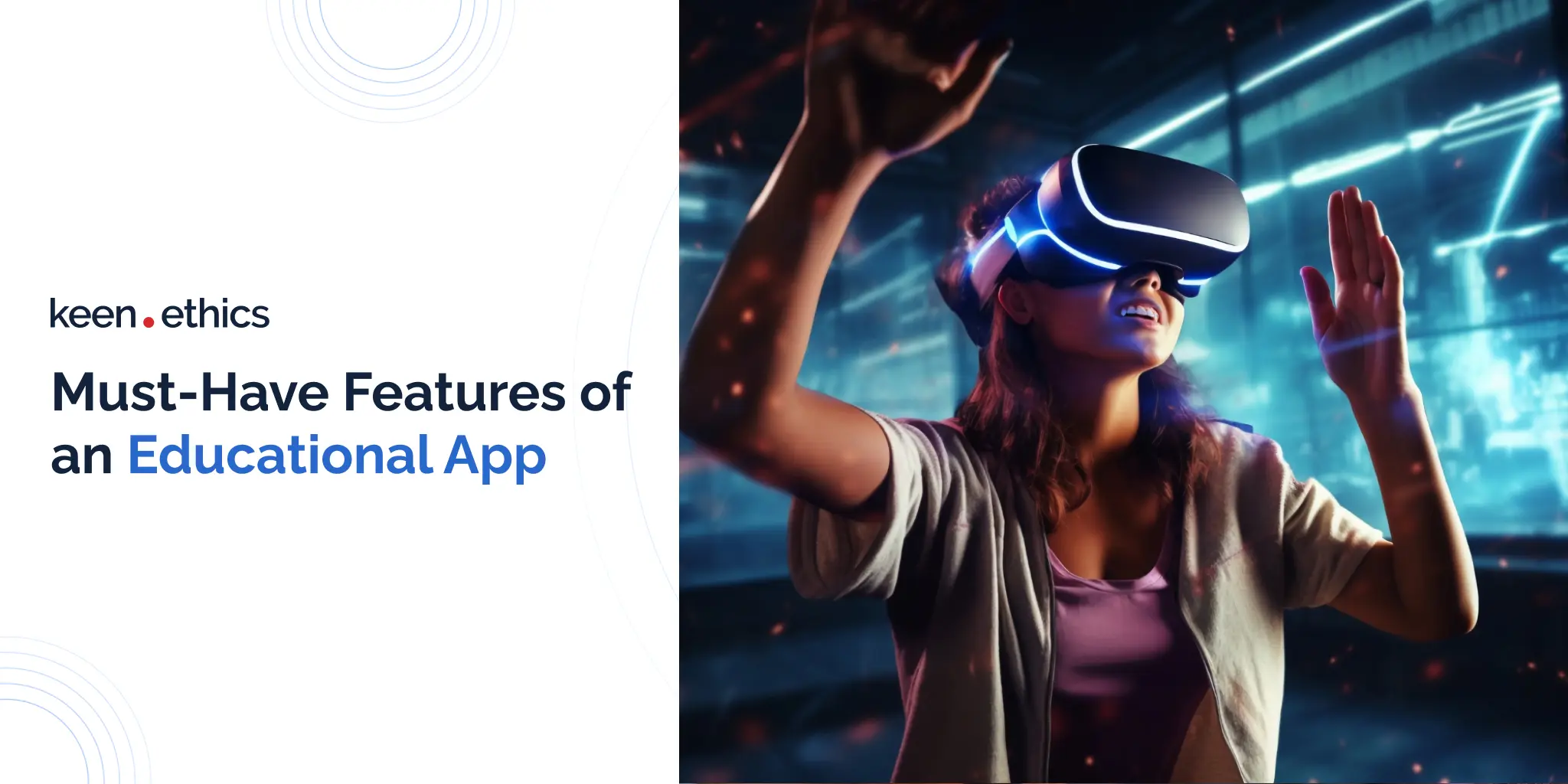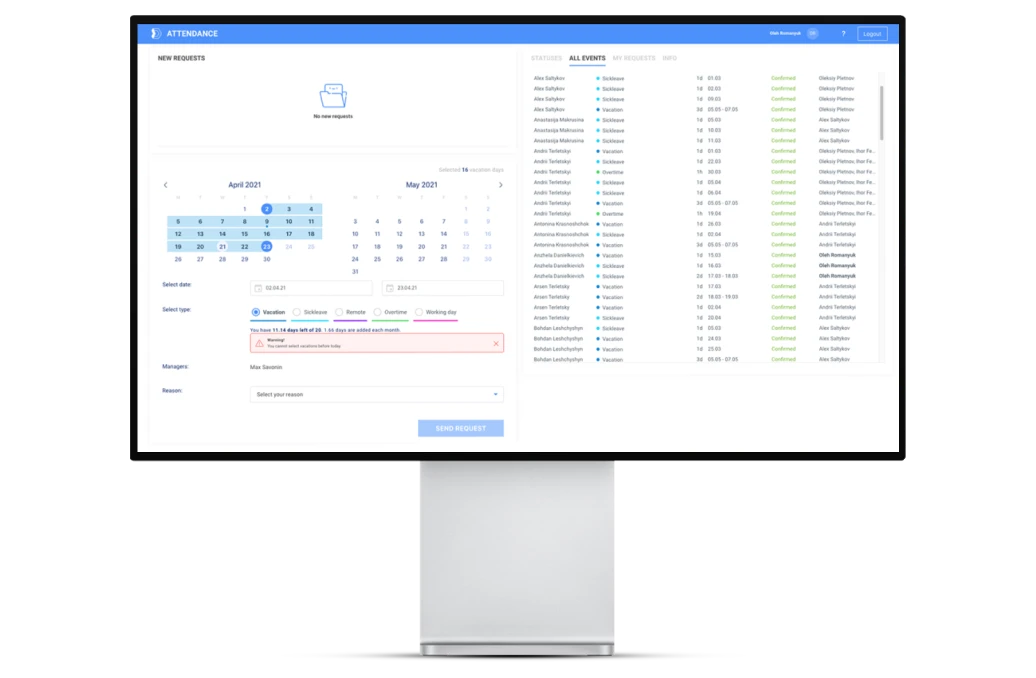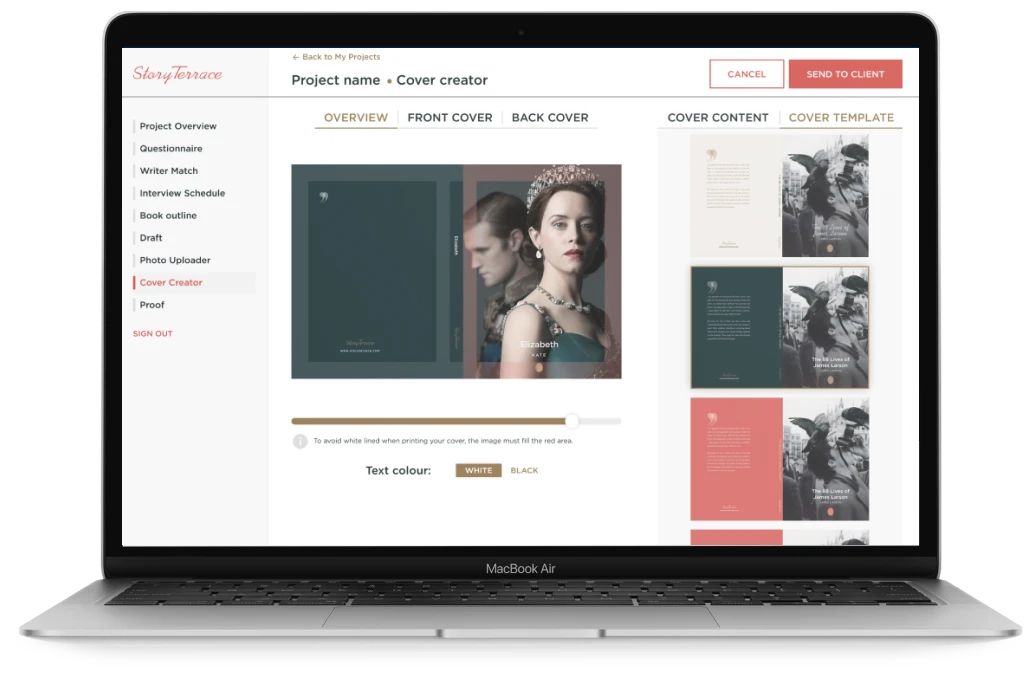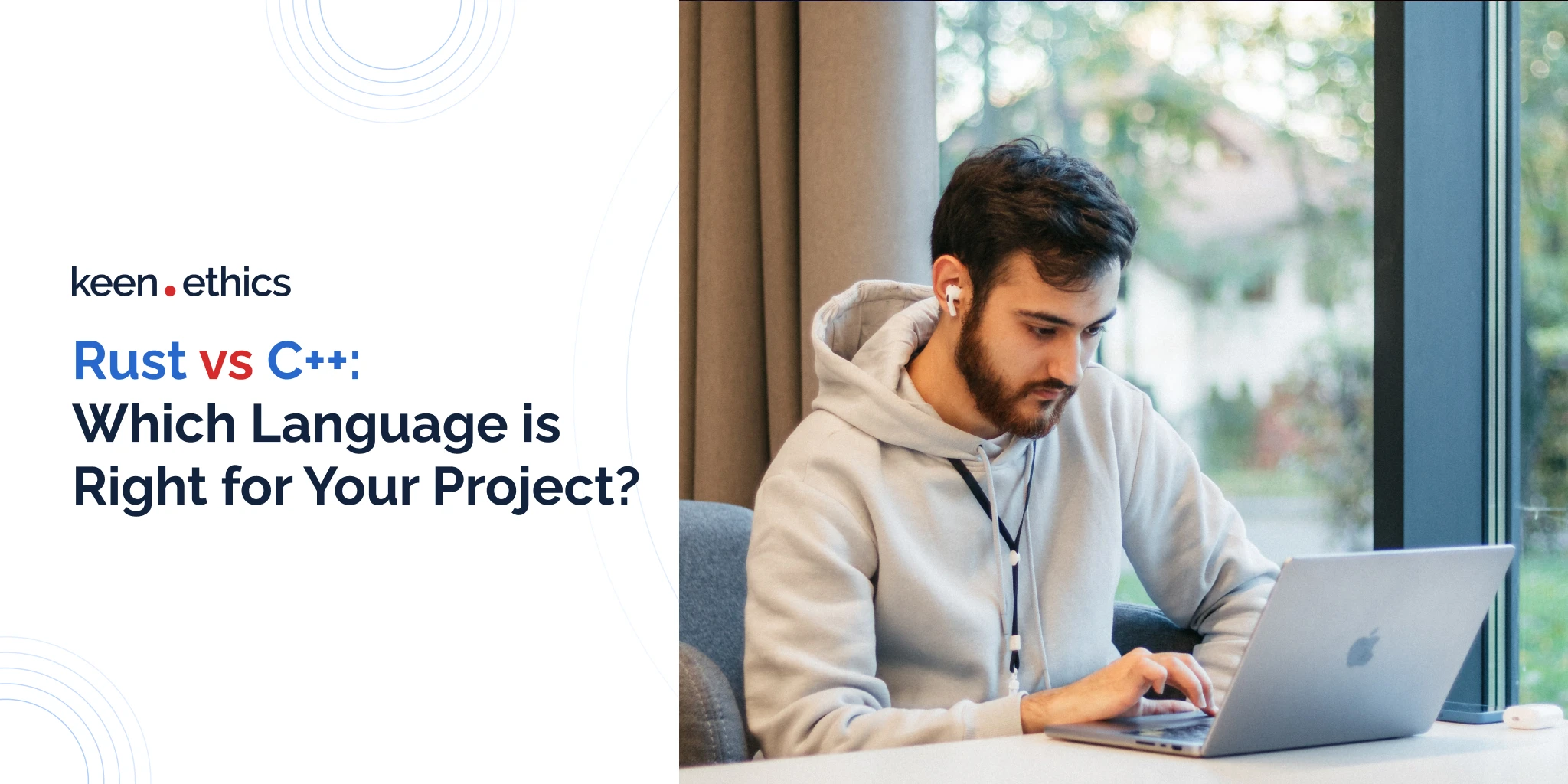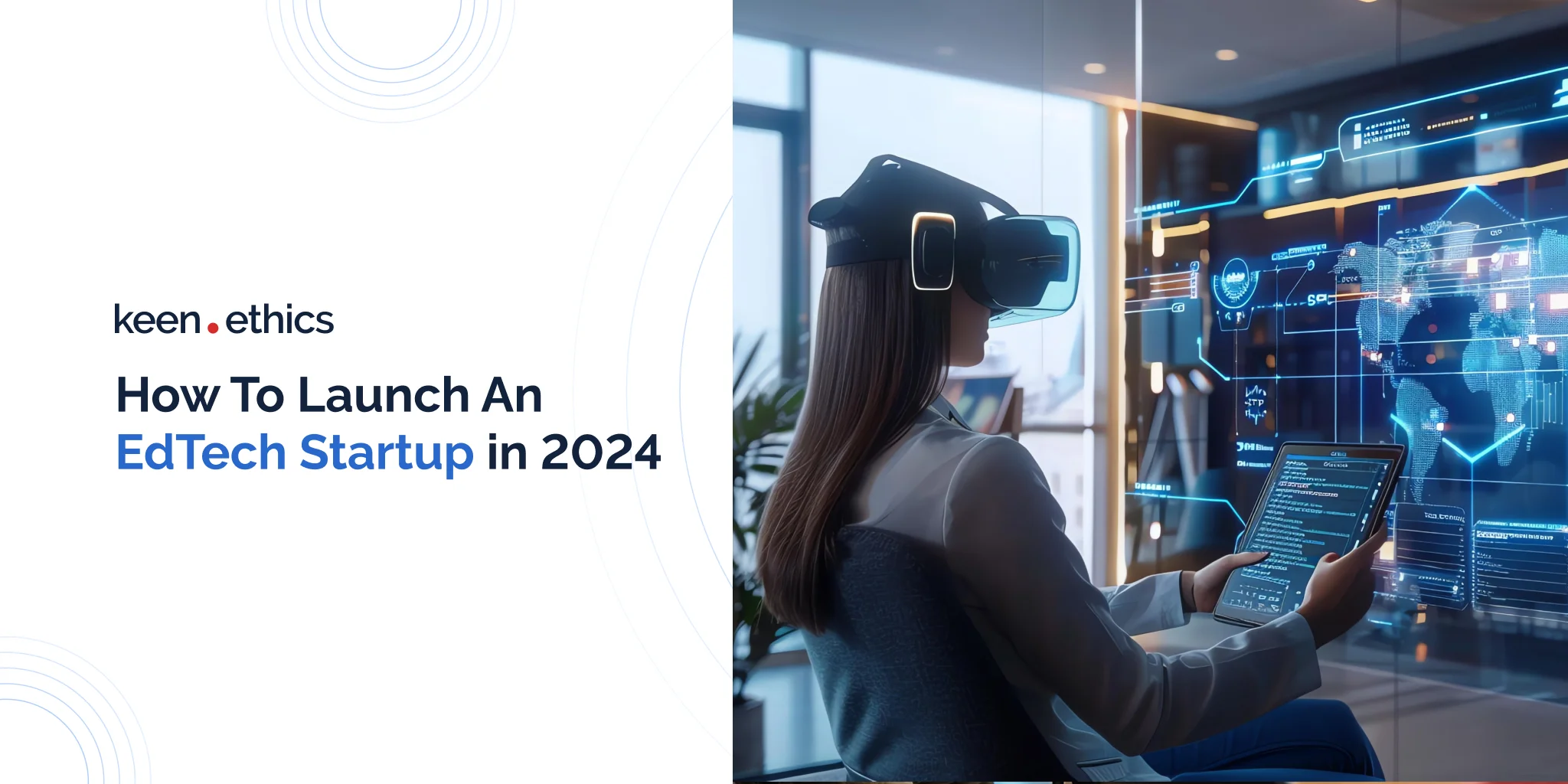All people who use their smartphones for studies agree upon a set of must-have e-learning mobile app features. For example, they include great UI/UX or a clear course structure. While some people put more emphasis on this feature or the other, there are common trends we need to consider. The main goal of this article is to review these trends and outline the core features of learning apps that you should consider for modern mobile devices. Using this information, you’ll be able to promote major transformations in your mobile learning apps and make them more valuable for the average users.
What Are the Core Reasons to Build a Mobile App for Your Education Business?

In our opinion, multiple vital benefits to building an education app for your mobile business exist. Let’s look at certain valuable insights all business managers should consider:
1) Great potential for revenues: the mobile app market is among the most profitable directions for investment in the modern world. In this regard, current information indicates that the e-learning sector will see an almost 300% growth within the next 10 years. If you have an innovative education product, then your chances in the mobile e-learning app market are high.
2) Relatively weak competition: today, the e-learning app market is seemingly full of various apps. Moreover, it has big players like Khan Academy or Duolingo. Nonetheless, all those options have significant issues that open a potential path to success for many newcomers. What are those problems? Above all, they come from the gap between theory and practice. Many earlier education app products were created without the involvement of learning specialists. If you have strong expertise in terms of learning methodology, then your chances of transforming the education sector in e-learning app stores are high.
3) Relatively low complexity of development: the modern edtech app market has a low barrier to entry. The relevant apps typically don’t require code that is too complicated: in numerous instances, the focus is on interfaces facilitating certain learning methods. What often distinguishes an app is educational content rather than its code.
4) Ability to promote your learning methods among a large audience: do you have a unique learning methodology? Do you think that it’s revolutionary? An education app is a strong way to share your learning process expertise with millions of other people. Using technological advancements, you can test if your approach is genuinely as high-value as you think by reviewing a large sample.
Core Benefits of Using Learning Apps

In our opinion, there are multiple benefits to using learning apps. Here are the core reasons to invest in this sector:
1) Promoting unique learning methods among a larger audience: a typical school is capable of spreading its method at best within one country or region. A potent app, in turn, is sufficient to promote a certain learning method among millions of people. This means you can turn your innovation in the education sector into a worldwide phenomenon.
2) Enabling continuous learning: various mobile apps for education are among the strongest pathways for enabling continuous learning. Why? Firstly, they allow many individuals to study without going to school at all. Secondly, they enable an opportunity for microlearning sessions. You can learn something while going to your job or having a break.
3) Promoting remote learning: education apps are outstanding due to enabling distance learning opportunities. You can use an education app from any place in the world. Why is this so vital? The reasons are rather simple: they promote access to high-quality learning courses for millions of people. It’s no longer necessary to visit educational institutions like Harvard to enjoy some of their courses.
What Are the Core Reasons for the Growth of the Edtech Market?

1. Making learning simpler
The primary reason why this market is growing so fast lies in the education app features that make learning easier. Firstly, they lower the access barriers to education. Secondly, e-learning apps are highly visible because of their ability to improve learner engagement through various microlearning sessions. Lastly, modern edtech apps remove the traditional difficulties associated with education. You can make your education journey inquiry-oriented with the use of education app features focused on AI. In short, these platforms promote continuous learning by making it fun.
2. The rising affordability of smartphones
A major reason why so many e-learning apps are appearing on the market stems from the rise of smartphone affordability. It’s not surprising that more and more individuals search learning experiences online. We believe the market for learning apps covers the majority of Earth’s population.
3. Improving the flexibility of learning
Modern learning apps are notable for making studies more flexible. We’ve already mentioned that they promote gamification or enable distance learning. But, that’s not all. What hides behind those benefits is one more positive aspect of innovation: modern apps disrupt the monopoly of traditional learning methods. This means the majority of the users get an opportunity to interact with a larger number of novel learning methods. For instance, the explosive growth of microlearning became the direct result of the education app spread.
Main Capabilities of Education Apps

Now that we know why one should invest in e-learning apps, it’s vital to find out what features for eLearning solutions are crucial in the current market. Let’s start our review:
Fast and secure databases
The primary feature a good learning app requires is a fast and secure database. Why? Firstly, it should be fast, since you need to provide tremendous amounts of data during the learning process. Secondly, a big factor to consider is security. Most learning apps contain a lot of information about the users. As a result, any leak of this data can have rather negative consequences for the average client. For instance, a course about literature that requires one to write essays may involve personal reflections capable of hurting a learner if they become public. Moreover, a mental health awareness course can feature even more vital information. Thus, it’s crucial to use databases to preserve user data in a state that is as intact as possible.
Friendly and comfortable UI/UX
Proper presentation is among must-have eLearning mobile app features. The reason why apps like Duolingo are so popular touches upon this factor. They deliver interfaces in multiple languages, and their functions offer real-time feedback. Matlab isn’t as popular not only because it’s specialized. There’s one more challenge: most people have to spend multiple months learning how to use it. A friendly user interface highlighting the core features of your app is game-changing. It pushes users to start focusing on the central functions from the get-go.
Streaming capabilities
Countless colleges in the modern world are centered on offering education that is fully online-centric. In this respect, having steaming capabilities is crucial. Why? While it’s more rational to record lectures and then publish them online, various Q&A sessions typically need live engagement. Many teachers need to come into contact with their students to help them with certain learning concerns. For example, a student may often have additional questions after covering the main issues. Only a live format can enable such adaptive learning. In this light, we highly recommend thinking about the steaming features in course apps early on.
Full-scale user accounts
A major strength of many education apps is the ability to personalize the learning journey of the involved individuals. No educational organization can do this as well as a learning app.
The core way to promote this personalization is the focus on the individual user accounts. In short, you should have the capability to create your learning records, which will be modified based on your decisions.
Individual learning accounts are important due to offering strong customization opportunities, too. For instance, they help users by enabling accessibility features or even comfort-oriented options, such as dark themes.
Course overview
One of the best learning methods is the so-called pre-study: it’s the practice of reviewing certain material before engaging with it directly. For example, many students in the West invest their time in reviewing the curricula of their courses to prepare themselves for the upcoming lectures. A good course overview is an essential feature for facilitating this practice, which is growing in popularity these days.
Systems for managing content
Many platforms aimed at elearning are focusing on community-oriented solutions. For instance, many apps allow various users to create full-scale courses for students. As long as you have a course of sufficient quality, it should be more than enough for registering on an educational platform like edX or Coursera.
For such community-oriented solutions, a core feature to enable is content management tools. The teachers should have the capability to add videos, texts, and audio. Moreover, there must be enough tools to create advanced structures for their courses that go beyond the video lesson format. The only way to achieve this is by giving full-scale editing and management tools with the support of core eLearning standards like SCORM and AICC.
Lesson summary
A major challenge for traditional learning design lies in the fact that you have to be present at certain lectures to record course information. For example, Ukrainian universities often make attendance compulsory for this reason: no other way to learn information exists. There’s also an additional problem. It’s not always clear what information is vital for an exam during lectures and which one isn’t. A significant chance of missing key information and failing to prepare for exams is present. So, what’s a solution? In our opinion, it comes in the form of full-scale lecture summaries. The users should have access either to the transcriptions of the lectures or to materials that cover the majority of their content.
Chat and forum capabilities
Communication is among the core advantages of traditional learning. In the majority of cases, you can ask your teachers about certain concepts and receive immediate answers.
For learning apps, this communication pathway is more complex. This means you should use features that minimize the downsides of such communication using cost-effective technology. In this light, traditional Internet technologies, which include chats and forums, are typically the best option for boosting performance. Chats enable you to engage in short communication sessions to resolve questions with minimal importance. In turn, forums allow for more complicated questions and long-term communication. Combined with live streams, those features should be sufficient to emulate the majority of the traditional positives stemming from live communication in the virtual environment.
Assessment configuration
Assessment is among the core elements of education. In many ways, people go to colleges to get assessed. In this respect, online education opens up many possibilities for cheating and other substandard behaviors. For this reason, it’s essential to have some tools for configuring the student assessments. Firstly, you must have instruments for different types of interactive reviews. The teachers should be able to create diverse quizzes and essay questions. Secondly, there must be some control tools, such as face-to-face camera-oriented proctoring. Current evidence suggests that they’re strong at decreasing cheating among modern learners.
Personalized learning
A core problem of traditional learning systems lies in their inability to personalize studying. Educational institutions typically work with dozens and even hundreds of people per classroom. As a result, the involved teachers don’t have enough time to interact with every student. This factor leads to a situation where some individuals may feel abandoned by the education system. Most likely, the deficit of teachers is among the core reasons why many nascent schools fail to produce adequate learning results.
Modern education apps may finally offer a solution to this issue. This possibility stems from the very model of educational mobile app development. A typical education app interacts with each user specifically instead of teaching a whole class. This factor is sufficient to enable personalized learning: a smartphone app can adapt to every user, contrary to traditional teachers.
Social media element integration
Social media sites like Facebook and Instagram have refined the formula for engaging clients. They attract millions and even billions of users daily by using a combination of algorithms and their social media interaction systems, such as repost and push notification functions. In many ways, it’s a great idea to use this strength of social media to boost a learning app. What can you do here? Firstly, integrate some user-made content into the platform. Allow the users to create their learning materials. Secondly, add social media buttons such as likes and provide algorithms that promote certain materials based on their amount and user interests.
Chatbot systems
Every user is likely to generate some questions about a particular service during their interaction with the app. Chatbots represent a strong solution in the presented case. Before generative AI, they were capable of answering user questions according to the pre-established algorithms. Currently, many organizations are using such chatbots in apps like Telegram. The rise of generative AI is especially revolutionary. We’ll see a major transformation in this sector because it enables human-like responses that don’t necessarily follow scripts, enabling a strong customization feature.
Analytical tools
What’s the core way in which humankind has managed to refine its education strategies? In our opinion, the answer here is simple: analytics. The ability to review past information and make judgments on it is central to any improvement-oriented strategy. In this respect, a mobile app development service offers strong options for its users. How exactly? These technologies allow the automated collection of information. As a result, it’s now possible to analyze more and more data.
Offline capabilities
One of the features most people dislike concerning all apps is the compulsory Internet connection. Regrettably, certain companies create tools that work only online. This is usually done to prevent piracy and other illegal methods of tampering with apps. Internet connection is truly compulsory only in some cases.
What’s our recommendation here? If possible, don’t make apps requiring a constant Internet connection at all. More importantly, you have the capability to combine Internet requirements with offline modes during application development. In this respect, do what YouTube does: allow the users to download certain videos or other learning materials. Duolingo Plus is notable for offering such a feature to its paying users.
Reminders and notifications
The best way to learn something is to learn it periodically. One of the strongest enemies of regularity in learning is the human tendency to forget. It’s not uncommon for us to create certain commitments and then do nothing with them. Consequently, we need a solution to this forgetting pattern. This solution comes in the form of notifications and reminders, which belong to some of the core mobile-first design principles. Such systems are easy to implement: you have to send users messages during a certain part of the day. Often, a reminder is more than sufficient to push a person towards engaging with a learning material.
Hand signal notifications
Traditional classrooms enable simple communication. For example, it’s enough for you to raise a hand to get an answer to your questions. With online systems, this aspect is much more difficult to replicate: after all, many teachers don’t see the students at all.
What’s a solution we can propose here? Try out hand signal notifications. Allow students to indicate hand-like emojis near their avatars during live streams. This is a technology that Google Meet and Zoom use. In our opinion, no livestream meeting app for students can work without it today.
Recording features
If you have an app enabling live meetings, a good idea is to have recording features. There are two reasons to have them, in our opinion. On the one hand, they enable the users to record lectures and make them available to absentees. On the other hand, the ability to record prevents various incidents. If students know they’re recorded, they’re unlikely to, for instance, upset a lesson by offending other students or a teacher. This feature is especially vital for the school system, where such incidents are common. Considering the ever-rising functionality for file storage, enabling this technology shouldn’t be difficult.
Virtual rooms (breakout)
Group work is an essential element of every efficient learning system. The key issue of traditional mass communication platforms like Google Meet is that this group work may require you to manually create separate meetings for everyone.
In this respect, a strong solution comes in the form of the breakout rooms. These are small sessions invented by Zoom that allow you to split all the people in a meeting into several isolated groups. We recommend paying attention to this feature if your app aims to focus on group work. It’ll give teachers enough flexibility to promote elaborate learning schemes, which are among the primary features for e-learning solutions. Complex tools like this one are a great way to establish a potent payment feature.
Sharing screen information
If you want to present a lecture to numerous people, it’s often a strong idea to supplement it with visuals. What’s the problem here? You should have some tools for sharing those visuals with the students.
The most common approach is to use the so-called screen sharing. This capability allows a person to showcase what they’re doing on their computer, acting as a camera that streams their workspace. Using this tool, a person can, for example, showcase a PowerPoint presentation supplementing their lecture.
Feature customization
Lastly, we recommend focusing on all types of customization for your app. The users should have the capability to regulate the features of an educational app according to their learning needs. What are the core elements to consider here? Firstly, you should have UI/UX customization to enable the users to make their everyday experience of using an app as comfortable as possible. Secondly, we recommend focusing on the learning customization capabilities. They may come in the form of difficulty levels or, for instance, analytical algorithms that personalize user experience.
Key Technologies for E-Learning Development
If you want to develop eLearning solutions, it’s crucial to look at various technologies for creating them on the market.
Generally, it’s possible to create an eLearning app with almost every programming language available. Nonetheless, there are clear favorites in the presented market. What are those favorites? Above all, they come in the form of modern web-oriented technologies.
Firstly, modern edtech apps benefit from JavaScript full-stack development. In this regard, you can try out Node.js or Deno. Why is this the case? It’s easy to build an e-learning app interface with the help of JavaScript. Consequently, platforms that promote full-stack development simplify the process even further.
Secondly, platforms like React and React Native may be essential for creating the UI/UX of the involved apps. For instance, React Native is notable for its support of multiple platforms. You can write code for interfaces in one language, JavaScript, and then enjoy a unified experience across multiple platforms.
In short, the best option for edtech development comes in the form of JavaScript-based technologies, since they enable fast web and mobile app creation.
Future Tendencies in Edtech App Development
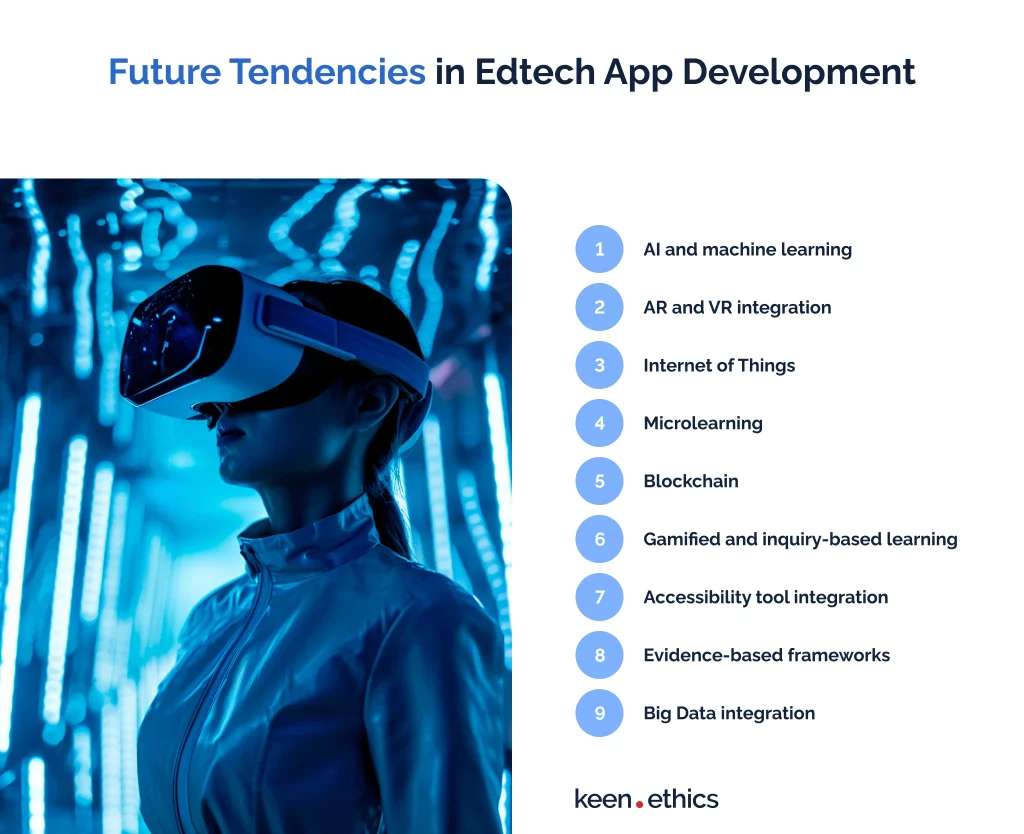
Ultimately, we also want to highlight future tendencies in the e-learning app features. Here are the top technologies you should consider while creating your app:
1. AI and machine learning
Machine learning and AI are going to have a vast transformative effect on education. On the one hand, we expect machine learning to promote changes in personalization. A machine learning framework can monitor the actions of the users and then adjust certain programs to their needs. On the other hand, modern AI is capable of creating content aimed specifically at individual users rather than the general audience. For instance, foreign language teachers use the platform to create exercises and texts for the learners.
2. AR and VR integration
Many concepts in the modern world require a person to have good 3D thinking. Not all people possess it: certain individuals are much better at interacting with the real world rather than abstract concepts. AR/VR solve this problem once and for all. How do they achieve this? Above all, by allowing to create fake 3D spaces or even insert 3D objects into real-life processes. Using such tools, teachers can explain complex concepts via virtual objects. This is a great way to work with students, who, for instance, possess the so-called aphantasia.
3. Internet of Things
More and more devices are integrated with computer chips capable of entering the Internet these days. We call this phenomenon the Internet of Things. Currently, there are myriads of smart TVs and even smart fridges on the market.
Most likely, we’ll also see an influx of such solutions in the education sector. Smart boards with access to the Internet or even smart pens may be the future of learning.
4. Microlearning
Many people who engage in proactive learning are busy. In this light, long learning sessions are a major issue for students. Some may lack time. Others may lack energy. What’s a solution? Microlearning. Small sessions that try to give the most benefit in the tiniest possible timeframe.
5. Blockchain
Blockchain is a technology aimed at creating records that are impossible to tamper with. Usually, its main benefits shine in the financial market that needs this level of precision.
Nonetheless, we see some potential benefits of blockchain in the edtech sector, too. Let’s imagine you have a national exam app. You can use blockchain for two goals: to verify the users and, more importantly, to prevent the illegal modifications of exam results. In our opinion, this technology will further boost education integrity in the upcoming years.
6. Gamified and inquiry-based learning
The core problem of traditional learning lies in the fact that it’s seen as hard work by the majority of people. Memorization and rereading take away all the fun from the learning process. As a result, the majority try to avoid studying instead of engaging in it.
Gamification and inquiry-based frameworks confront this challenge once and for all. On the one hand, gamification turns learning into a game, creating additional motivation for studies. On the other hand, inquiry-based studying is notable for its ability to turn knowledge acquisition into a “detective” story, where a person investigates an unknown topic from multiple perspectives. In short, we can see these learning methods as a strong way to enhance student motivation.
7. Accessibility tool integration
These days, up to 1.3 billion people in the world face some form of disability. Many of them directly affect the ability of the users to interact with mobile apps. Thus, accessibility is among the core features of an educational mobile app if you want to maximize your audience numbers. In numerous instances, proper accessibility capabilities allow attracting up to 15% more people.
What are the adjustments we recommend? Try out additions such as voice control, screen readers, and color blindness modes. They’re sufficient to cover the majority of the users’ needs.
8. Evidence-based frameworks
A significant problem of various earlier apps on the edtech market was their distance from proper evidence-based frameworks. Regrettably, many frameworks were created by people who had no higher education in the sphere of learning science.
Today, we’re seeing a shift towards solutions that consider novel methods. For example, many apps on the market now use interleaving. The rise of AI is perfect for inquiry-based and personalized learning. All in all, a shift towards efficient methods rather than traditional ones is occurring in the market.
9. Big Data integration
A final element to consider is the rise of the so-called Big Data. Modern mobile education apps collect tremendous amounts of information about the users and their behaviors. In many cases, this data is so big that it’s impossible to analyze for humans.
What makes this information valuable is the rise of machine learning. Using modern AI and machine learning tools, it’s possible to mine tremendous amounts of useful insights. These insights are essential for transforming learning these days.
Summing up
To summarize, investments in the e-learning sector appear to be highly rational in the current conditions. Firstly, this sector is noteworthy for its great growth potential. Secondly, it has various niches, such as evidence-based learning, which are far from being saturated at this point. Lastly, we can also note that there’s a market for company-specific solutions, since many businesses have unique learning needs.
FAQ
What do elearning apps stand for?
Are educational apps a worthy time investment for users?
In our opinion, the answer depends on the efficiency of the methods they’re using. Certain apps have great interfaces but use completely inefficient learning methodologies. In turn, other solutions are notable for including evidence-based frameworks. Anki is a good example of an evidence-based app. Focused on spaced repetition, it’s a perfect framework for memorizing many small, unconnected details.
What features do learning apps have?
Every learning app depends on different sets of features. Some of the most common methodologies include a focus on the following elements:
1) Personalization;
2) AI usage;
3) Microlearning;
4) Livestreaming capabilities;
5) Accessible interface;
6) Offline access.
Address Keenethics to start developing a high-quality app.
 Search
Search

